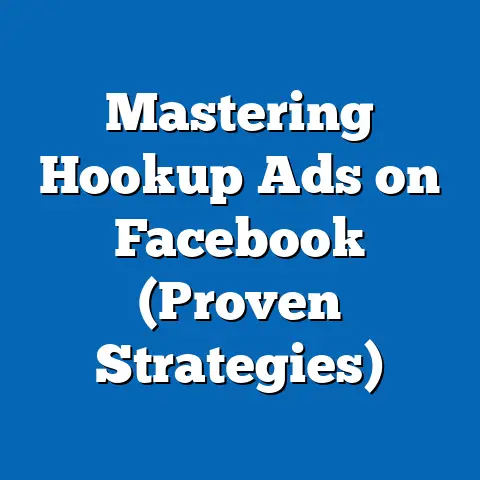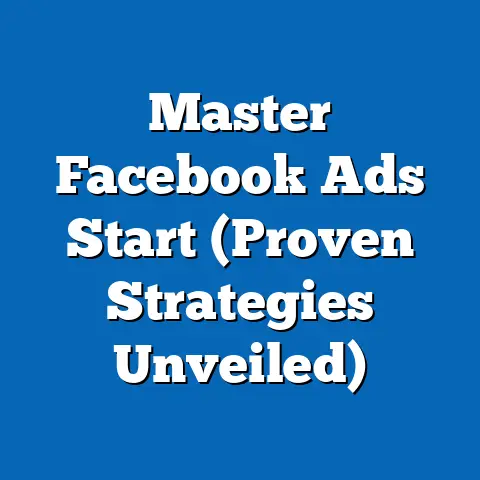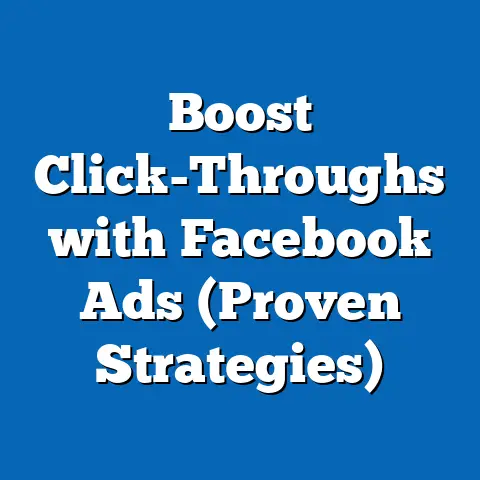Revive Facebook Ads: A Recovery Blueprint (Expert Guide)
Facebook advertising, once the undisputed titan of digital marketing, has faced significant challenges in recent years due to privacy changes, platform saturation, and shifting user demographics. However, experts agree that with the right strategies, advertisers can revive their campaigns and achieve substantial returns on investment (ROI). According to a 2023 report by eMarketer, Facebook ad spending is projected to reach $58.11 billion globally in 2023, a 9.2% increase from 2022, despite a slowdown compared to the 19.6% growth seen in 2021.
Key statistical trends reveal a nuanced landscape: while overall user growth on Facebook has stagnated in mature markets like the U.S. and Western Europe, emerging markets in Asia-Pacific and Latin America are driving new user acquisition, with a 6.3% year-over-year increase in monthly active users (MAUs) in these regions as of Q2 2023 (Meta Investor Reports). Demographically, younger audiences (18-24) are spending less time on the platform, with a 12% decline in daily active users (DAUs) in this cohort since 2019, while older users (35-54) have increased engagement by 8.4% over the same period.
Historically, Facebook ads boasted click-through rates (CTRs) averaging 1.72% in 2017 across industries, but this has dropped to 0.90% in 2023 (WordStream Ad Benchmarks), reflecting increased competition and ad fatigue. Looking forward, experts predict a recovery in ad effectiveness by 2025 if advertisers adapt to privacy-first policies like Apple’s App Tracking Transparency (ATT) framework and leverage Meta’s AI-driven ad tools, which have already shown a 32% improvement in ad relevance scores for early adopters (Meta Business Insights, 2023). This article dives deep into the data, offering a recovery blueprint for advertisers to navigate these challenges and capitalize on emerging opportunities.
Detailed Analysis: Understanding the Decline of Facebook Ads
The Impact of Privacy Changes and Platform Policies
The decline in Facebook ad performance can be traced to significant disruptions in data tracking and user privacy policies. Apple’s introduction of ATT in 2021, which requires apps to obtain explicit user consent for tracking, has impacted 62% of iOS users who opted out of tracking, severely limiting Facebook’s ability to deliver personalized ads (Flurry Analytics, 2022). This has led to a reported $10 billion loss in ad revenue for Meta in 2022 alone (Meta Annual Report).
Additionally, Meta’s own pivot toward privacy with restricted third-party data access has reduced the granularity of targeting options. Small businesses, which account for 70% of Facebook advertisers (Meta Small Business Report, 2023), have felt this pinch the most, with 54% reporting a drop in campaign ROI post-ATT implementation.
The result is a measurable decline in key performance metrics: cost-per-click (CPC) has risen by 17% since 2021, averaging $0.97 in 2023, while return on ad spend (ROAS) has decreased by 15% for industries like e-commerce (WordStream, 2023). Advertisers must now rethink their reliance on hyper-targeted ads and focus on broader, interest-based strategies to regain traction.
User Demographic Shifts and Engagement Patterns
Demographic trends are another critical factor in the evolving Facebook ad landscape. As of 2023, Facebook’s global user base stands at 2.98 billion MAUs, but growth is unevenly distributed. In the U.S. and Canada, MAUs have remained flat at 198 million since 2020, while regions like India and Brazil have seen double-digit growth, contributing to a 7% overall increase in global users (Meta Q2 2023 Earnings).
Age demographics paint a stark picture of shifting engagement. Gen Z (18-24) users, once a core audience, have reduced their time spent on Facebook by 16% since 2019, favoring platforms like TikTok and Instagram (Pew Research Center, 2023). Conversely, users aged 35-54 now account for 42% of daily active users in the U.S., up from 38% in 2019, with higher engagement rates in content related to lifestyle and local news.
Gender-wise, the platform remains balanced, with 56% male and 44% female users globally, though women in the 25-34 age group show a higher ad interaction rate (1.1% CTR) compared to men (0.8% CTR) in the same cohort (Hootsuite Digital Trends, 2023). These shifts suggest advertisers must recalibrate their creative and targeting strategies to align with older, more engaged demographics while exploring growth markets for younger audiences.
Ad Fatigue and Rising Competition
Ad fatigue, driven by oversaturation, is a growing concern for Facebook advertisers. With over 10 million active advertisers on the platform as of 2023 (Meta Business Insights), users are exposed to an average of 12 ads per session, leading to a 22% increase in ad blindness compared to 2018 (Nielsen Digital Ad Ratings). This oversaturation has contributed to the drop in average CTR from 1.72% in 2017 to 0.90% in 2023.
Competition from other platforms like TikTok, which saw a 50% increase in ad spend in 2022, and Google Ads, with its dominance in search intent (capturing 28.5% of global digital ad spend), has further pressured Facebook’s market share (eMarketer, 2023). Advertisers report that 41% of their budgets are now allocated to short-form video platforms, up from 25% in 2020, reflecting a pivot away from static Facebook ads.
The challenge lies in creating standout content amidst this clutter. Data shows that video ads on Facebook still achieve a 1.2% CTR, 33% higher than image-based ads, indicating a path forward for brands willing to invest in dynamic formats (WordStream, 2023).
Statistical Comparisons Across Demographics
Age-Based Performance Metrics
Analyzing ad performance across age groups reveals significant disparities. For users aged 18-24, ad engagement has declined, with a CTR of just 0.7% in 2023, down from 1.1% in 2019. This group also shows a higher cost-per-acquisition (CPA), averaging $14.50, as they are less likely to convert due to limited purchasing power and platform disengagement (AdEspresso Benchmarks, 2023).
In contrast, the 35-54 age group demonstrates a CTR of 1.3%, with a lower CPA of $9.80, reflecting higher intent and disposable income. Older users (55+) also show promise, with a steady CTR of 1.0% and the lowest CPA at $8.20, driven by targeted campaigns for health, finance, and travel sectors.
These metrics underscore the need for age-specific creative strategies: younger audiences may respond better to influencer-driven or interactive content, while older users are more receptive to value-driven messaging and direct calls-to-action.
Geographic Variations in Ad Effectiveness
Geographic data highlights stark contrasts in ad performance. In North America, where ad saturation is high, the average CPC stands at $1.10, with a ROAS of 3.2x in 2023, down from 4.5x in 2019 (WordStream Regional Data). Western Europe mirrors this trend, with a CPC of $0.95 and ROAS of 3.0x.
Emerging markets, however, offer a brighter outlook. In Asia-Pacific, the CPC averages $0.45, with a ROAS of 5.1x, driven by lower competition and a growing middle class. Latin America similarly reports a CPC of $0.38 and ROAS of 5.8x, with Brazil and Mexico leading user growth at 9% and 7% respectively (Meta Regional Insights, 2023).
These figures suggest that advertisers should allocate budgets toward high-growth regions while optimizing North American campaigns for niche, high-value audiences to counteract rising costs.
Industry-Specific Ad Performance
Industry data reveals varying levels of success on Facebook. E-commerce, which accounts for 30% of ad spend, has seen a decline in ROAS from 6.2x in 2018 to 3.8x in 2023, largely due to tracking limitations post-ATT. Conversely, the education sector reports a stable ROAS of 4.5x, benefiting from targeted lead generation campaigns for online courses (AdEspresso Industry Report, 2023).
Entertainment and media industries have adapted well to video content, achieving a CTR of 1.5% compared to the platform average of 0.9%, while finance and insurance lag at 0.6% CTR due to stricter ad policies and lower user trust. Tailoring ad formats and messaging to industry strengths—video for entertainment, trust-building for finance—will be critical for recovery.
Historical Trend Analysis: Facebook Ads Over the Decades
The Golden Era: 2010-2017
Facebook’s early ad platform, launched in 2007, evolved into a powerhouse by the early 2010s, offering unparalleled targeting based on user data. Between 2010 and 2017, ad revenue grew at a compound annual growth rate (CAGR) of 49%, reaching $40.7 billion by 2017 (Meta Historical Financials). Average CTRs during this period peaked at 1.72%, with CPCs as low as $0.25 in 2012, making it a cost-effective channel for businesses of all sizes.
This era was marked by minimal competition and high user engagement, with MAUs growing from 608 million in 2010 to 2.13 billion by 2017. Small businesses, in particular, thrived, with 5 million active advertisers by 2017, leveraging precise demographic and interest-based targeting.
The Transition Period: 2018-2021
The late 2010s brought challenges as privacy scandals, such as the 2018 Cambridge Analytica incident, eroded user trust and prompted regulatory scrutiny. Ad revenue growth slowed to a CAGR of 25% between 2018 and 2021, though it still reached $114.9 billion by 2021. CTRs began declining, averaging 1.2% by 2020, as users grew wary of data misuse and ad oversaturation increased.
The introduction of GDPR in Europe in 2018 and CCPA in California in 2020 forced Meta to adjust data practices, impacting ad personalization. Despite this, user growth continued, reaching 2.91 billion MAUs by 2021, though North American engagement plateaued.
The Current Landscape: 2022-2023
Post-2021, the ATT rollout and Meta’s privacy pivot have defined the current era. Ad revenue growth dropped to a CAGR of 8%, with 2022 marking the first year of negative growth (-1.1%) due to tracking challenges (Meta Annual Report, 2022). CTRs hit a low of 0.9%, and CPCs rose to $0.97, reflecting a tougher environment for advertisers.
However, Meta’s investment in AI tools, like Advantage+ campaigns, has shown early promise, with a 20% reduction in CPA for brands using automated placements (Meta Business Case Studies, 2023). User growth in emerging markets also offers hope, though mature markets remain a concern.
A Recovery Blueprint: Strategies to Revive Facebook Ads
Leverage AI and Automation Tools
Meta’s AI-driven ad tools, such as Advantage+ Shopping Campaigns, are proving effective in navigating privacy restrictions. Early data shows a 32% improvement in ad relevance and a 15% reduction in CPC for brands using these tools (Meta Insights, 2023). Automation allows advertisers to optimize for broad audiences while relying on machine learning to refine targeting.
To implement this, advertisers should allocate 20-30% of their budget to test automated campaigns, focusing on high-intent objectives like conversions over reach. Continuous monitoring and creative refreshes are essential to maintain performance.
Focus on Video and Interactive Content
Video content remains a standout format, with a 1.2% CTR compared to 0.8% for static ads. Short-form videos under 15 seconds achieve 60% higher completion rates, aligning with user preferences for quick, engaging content (Hootsuite Video Trends, 2023). Interactive formats like polls and carousel ads also boost engagement by 18% on average.
Brands should invest in video production, prioritizing authentic, user-generated content over polished ads. Testing interactive elements in Stories and Reels, which reach 1.4 billion users daily, can further amplify results (Meta Engagement Stats, 2023).
Target Emerging Markets and Older Demographics
Given the high ROAS in Asia-Pacific (5.1x) and Latin America (5.8x), advertisers should localize campaigns for these regions, adapting to cultural nuances and languages. For older demographics (35-54 and 55+), focus on value-driven messaging around health, finance, and lifestyle, which resonate with their 1.3% and 1.0% CTRs, respectively.
Budget allocation should reflect these priorities: 40% to emerging markets for growth, 30% to older demographics for stability, and 30% to experimental campaigns targeting younger users through Reels and influencer partnerships.
Optimize for First-Party Data and Privacy Compliance
With third-party data diminishing, first-party data collection via lead forms, quizzes, and website pixels is critical. Brands using first-party data report a 25% higher ROAS compared to those relying solely on platform data (Forrester Digital Marketing Report, 2023). Compliance with privacy laws like GDPR and CCPA is non-negotiable, with 78% of users more likely to engage with transparent brands (Pew Research Privacy Survey, 2023).
Implement consent management platforms (CMPs) to ensure compliance and build trust. Use Meta’s Conversions API to track events without cookies, improving attribution by up to 30% (Meta Developer Insights, 2023).
Future Projections: The Road to Recovery by 2025
Looking ahead, experts project a moderate recovery for Facebook ads, with global ad spend expected to grow at a CAGR of 10% from 2023 to 2025, reaching $71.5 billion by 2025 (eMarketer Forecast). This growth will be driven by AI advancements, with Meta estimating that 50% of advertisers will adopt automated tools by 2024, reducing CPA by an additional 10-15%.
User growth is expected to stabilize at 3.1 billion MAUs by 2025, with Asia-Pacific contributing 60% of new users. Engagement among younger demographics may remain challenging, though Reels and cross-platform integration with Instagram could recapture 5-7% of Gen Z users if creative strategies improve (Pew Digital Trends Forecast, 2023).
Ad performance metrics are projected to stabilize, with CTRs potentially rebounding to 1.1% by 2025 as advertisers adapt to privacy-first environments and refine content. CPCs may rise slightly to $1.05 due to ongoing competition, but ROAS could improve to 4.2x with better targeting and AI optimization (WordStream Projections, 2023).
The implications are clear: advertisers who invest in adaptability—embracing AI, prioritizing video, targeting growth markets, and respecting privacy—will lead the recovery. Those who cling to outdated hyper-targeting models risk falling behind in an increasingly dynamic digital ad landscape. By following this blueprint, brands can not only revive their Facebook ad campaigns but also position themselves for long-term success in a privacy-centric, user-focused future.






